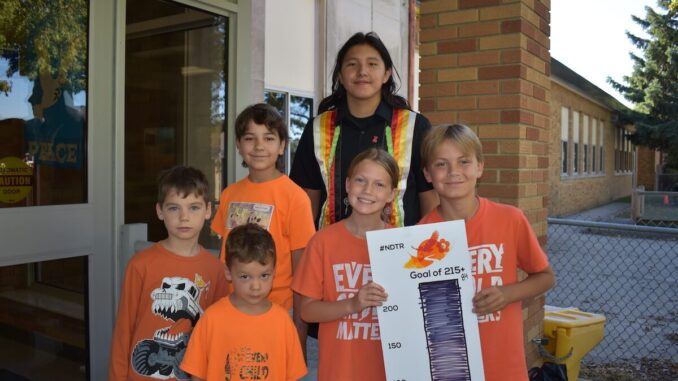
By Matt Weinagrden, Local Journalism Initiative Reporter, Lakeshore News Reporter
A sea of orange shirts filled the rear courtyard of St. Pius X Catholic Elementary School in Tecumseh the morning of Sept. 30th, as nearly 700 students gathered to observe the fifth National Day for Truth and Reconciliation, a day where Canadians reflect on the legacy of residential schools and remember the survivors and those who never made it home.
The event offered a moving tribute to Indigenous communities and the children lost to Canada’s residential school system.
The ceremony’s emotional centerpiece was the performance of 15-year-old Indigenous drummer, Mgiizi Wright, whose resonant rhythms provided an authentic voice to the morning’s reflection and remembrance.
Following the assembly, students participated in a silent walk past a striking display of 215 pairs of used shoes, carefully placed along the school’s front pathway. The installation served as a somber memorial to the 215 children whose unmarked graves were discovered at former residential school sites—a haunting reminder of the lives lost and the lasting impact of the residential school era.
The National Day for Truth and Reconciliation recognizes the legacy of the residential school system, which operated in Canada from 1857 to 1996. During that time, more than 150,000 Indigenous children were forced to attend church-run, government-funded schools, where they were often separated from their families and prohibited from speaking their languages. An estimated 6,000 children died while attending these institutions, though experts believe the actual number could be much higher.
Melissa Mills, a parent of two St. Pius X students and a member of the Catholic School Advisory Committee, helped organize the assembly and shoe drive. She explained that the school community collected the shoes in just three days, ultimately gathering 305 pairs, which will be donated to communities in Northern Ontario.
“We came together as a school community to collect 215 plus one pairs of new and gently used shoes to represent each of the bodies found in unmarked graves at the Kamloops residential school four years ago,” Mills said. “It’s important to honour the legacy of residential school survivors.”
She reflected on her own school years, noting the absence of Indigenous history and culture in her curriculum. “When I was growing up, we didn’t have any mention of Indigenous culture or learning or residential schools.”
She applauds the Ontario government for making the event an important part of learning now.
“I do not identify as Indigenous; I do consider myself to be an Indigenous ally, and I just wanted an opportunity to give back,” said Mills. “I believe in truth and reconciliation and so this is my way to act and honour a really shameful part of Canadian history.”
